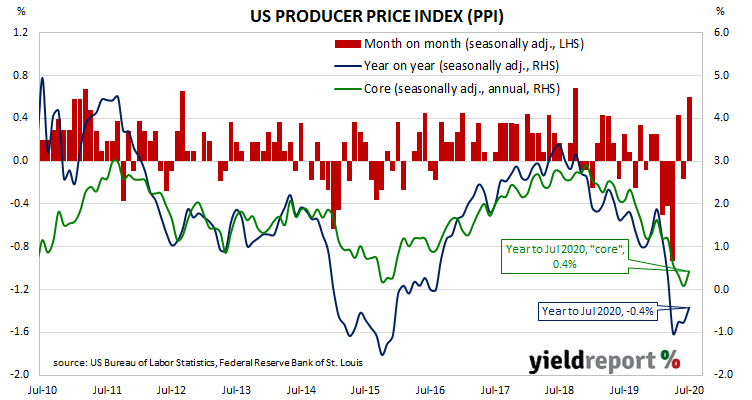Summary: Prices received by producers increase noticeably on average; rise double expected figure; annual “core” PPI moves away from zero; long-term US bond yields jump; PPI rise driven by both higher goods and services prices.
Around the end of 2018, the annual inflation rate of the US producer price index (PPI) began a downtrend which then continued through 2019. Months in which prices received by producers increased suggested the trend may have been coming to an end, only for it to continue. The downtrend turned into a plunge in April.
The latest figures published by the Bureau of Labor Statistics indicate producer prices rose by 0.6% after seasonal adjustments in July. The increase was double to the 0.3% rise which had been generally expected and in contrast to June’s 0.2% fall. On a 12-month basis, the rate of producer price inflation after seasonal adjustments increased to -0.4%, higher than the -0.8% annual rate recorded in May and June.

Core PPI inflation increased by more than expected. PPI inflation excluding foods and energy rose by 0.5% after recording consecutive declines in 0.3% in June and 0.1% in May. The annual rate increased from 0.1% to 0.4%.
US Treasury bond yields finished higher across the curve, especially at the long end. By the end of the day, the US 2-year yield had added 2bps to 0.15%, the 10-year yield had gained 6bps to 0.64% while the 30-year yield finished 8bps at 1.33%.
The BLS stated higher prices for final demand services were the main drivers of the month’s increase after they rose by 0.5% on average. Prices of goods increased by 0.8% on average.
The producer price index (PPI) is a measure of prices received by producers for domestically produced goods, services and construction. It is put together in a fashion similar to the consumer price index (CPI) except it measures prices received from the producer’s perspective rather than from the perspective of a retailer or a consumer. It is another one of the various measures of inflation tracked by the US Fed, along with core personal consumption expenditure (PCE) price data.

